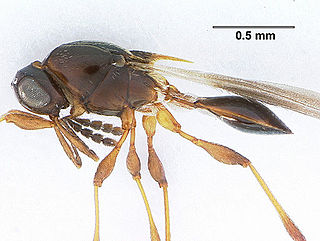
The Hymenopteran superfamily of parasitoid wasps, Platygastroidea, has often been treated as a lineage within the superfamily Proctotrupoidea, but most classifications since 1977 have recognized it as an independent group within the Proctotrupomorpha. It is presently has some 4000 described species. They are exclusively parasitic in nature.

The hymenopteran family Platygastridae is a large group of exclusively parasitoid wasps, mostly very small (1–2 mm), black, and shining, with geniculate (elbowed) antennae that have an eight-segmented flagellum. The wings sometimes lack venation, though they may have slight fringes of setae.

The hymenopteran family Scelionidae is a very large cosmopolitan group of exclusively parasitoid wasps, mostly small (0.5–10 mm), often black, often highly sculptured, with (typically) elbowed antennae that have a 9- or 10-segmented flagellum. It was once considered to be a subfamily of the Platygastridae, but has been revived in the most recent classification of Platygastroidea.

The Stephanidae, sometimes called crown wasps, are a family of parasitoid wasps. They are the only living members of the superfamily Stephanoidea. Stephanidae has at least 345 living species in 11 genera. The family is considered cosmopolitan in distribution, with the highest species concentrations in subtropical and moderate climate zones. Stephanidae also contain four extinct genera described from both compression fossils and inclusions in amber.

Scelio is a large genus, the largest within the family Scelionidae, of parasitic wasp whose known target host include the eggs of grasshoppers. They are found worldwide and some species have been implemented as biological control agents.

Neanaperiallus is an extinct monotypic genus of parasitic wasp in the Eupelmidae subfamily Neanastatinae containing only a single species, Neanaperiallus masneri. The genus is solely known from the Early Eocene Baltic amber deposits in the Baltic Sea region of Europe.

Trissolcus japonicus, the samurai wasp, is a parasitoid wasp species in the family Scelionidae, native to east Asia but now found in Europe, North America, and Chile. It is chiefly known for parasitizing Halyomorpha halys. It deposits eggs into the eggs of the stink bug, and as the wasp larvae develop, they kill the stink bug eggs. A single adult wasp emerges from each stink bug egg.

New Jersey Amber, sometimes called Raritan amber, is amber found in the Raritan and Magothy Formations of the Central Atlantic (Eastern) coast of the United States. It is dated to the Late Cretaceous, Turonian age, based on pollen analysis of the host formations. It has been known since the 19th century, with several of the old clay-pit sites now producing many specimens for study. It has yielded a number of organism fossils, including fungi, plants, tardigrades, insects and feathers. The first identified Cretaceous age ant was described from a fossil found in New Jersey in 1966.
Synopeas is a genus of parasitoid wasps in the family Platygastridae. There are about 400 described species in Synopeas.
Oethecoctonus is a genus of parasitoid wasps in the family Platygastridae. There are about six described species in Oethecoctonus.
Metaclisis is a genus of parasitoid wasps in the family Platygastridae. There are at least 30 described species in Metaclisis.
Trichacis is a genus of parasitoid wasps in the family Platygastridae. There are more than 60 described species in Trichacis.
Idris is a genus of parasitic wasps in the family Platygastridae, containing about 160 described species. This genus is part of the tribe Baeini, which are egg parasitoids. Members of the genus Idris are mostly parasitoids of spider eggs, but at least one member of the genus uses stink bugs as hosts.

Proterosceliopsis is an extinct genus of platygastroid parasitic wasp, known from the Mid-Cretaceous of Eurasia. The genus was first described in 2014 from the Albian amber of the Escucha Formation. In 2019 additional species were described from the Cenomanian-age Burmese amber, and was placed into the monotypic family Proterosceliopsidae.
Burmese amber is fossil resin dating to the early Late Cretaceous Cenomanian age recovered from deposits in the Hukawng Valley of northern Myanmar. It is known for being one of the most diverse Cretaceous age amber paleobiotas, containing rich arthropod fossils, along with uncommon vertebrate fossils and even rare marine inclusions. A mostly complete list of all taxa described up until 2018 can be found in Ross 2018; its supplement Ross 2019b covers most of 2019.
Sparasion is a genus of wasps belonging to the family Sparasionidae, whitin the superfamily Platygastridae. The genus has specimens widespread in Eurasia, Africa, and temperate North America.

Neuroscelionidae is a family of wasps in the superfamily Platygastroidea. It contains only one extant genus, Neuroscelio, with two other genera known from fossils. Members of Neuroscelio are known from Southeast Asia and Australia. Their hosts are unknown.

Nixonia is a genus of wasps. It is the only member of the family Nixoniidae in the superfamily Platygastroidea. They are amongst the largest of the platygastroids at up to 9 mm in length. Members of the genus are known from Africa, the Indian subcontinent and Southeast Asia. The biology of only one species is known, which parasitises orthopteran eggs.

Geoscelionidae is a family of wasps in the superfamily Platygastroidea. It contains three extant species in two genera, native to South America and Africa, and several other genera known from fossils. It was originally erected as the tribe Geoscelionini within Scelionidae. It was raised to a full family in 2021.

Sparasionidae is a family of wasps in the superfamily Platygastroidea. Known species are parasitioids of the eggs of orthopterans.













